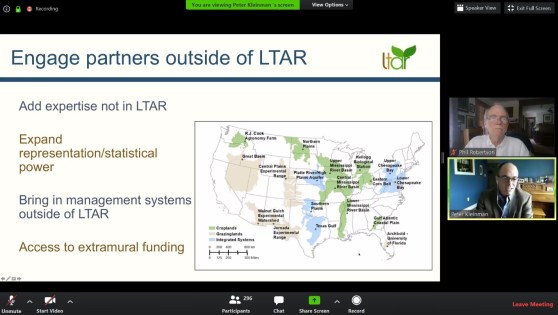Author: Hilary Swain

Dr. Phil Robertson and Dr. Peter Kleinman with their presentation on the USDA LTAR network at the annual meeting, held this year via Zoom. Screenshot by Caro Cordova.
Archbold’s Buck Island Ranch, partnering with the University of Florida Range Cattle Research and Education Center in Ona, is one of 18 sites nationwide in the Long-Term Agroecosystem Research LTAR network of the U.S. Department of Agriculture (https://ltar.ars.usda.gov). This year’s annual LTAR scientist meeting was originally planned for the last week of April, 2020 at Kellogg Biological Station, Michigan State University (MSU). At the LTAR Leadership meeting in Beltsville, Maryland at the beginning of March the full dimensions of COVID-19 became apparent. Dr. Hilary Swain, Archbold Director describes the deliberations, “It was clear that an in-person LTAR meeting would be impossible. Recognizing that the LTAR scientists nationwide had set aside meeting days in their calendar, the organizers at Michigan State University made a bold decision—rather than canceling or postponing they pivoted to offer an on-line Zoom meeting, and furthermore agreed to get this done in less than 8 weeks!”
By now most of the US has viewed celebrities and news anchors sharing information and entertaining us from their homes, but how would scientists, without event planning training, manage the programs and interactions of a professional online meeting? Dr. Phillip Robertson, ecologist at Michigan State University (MSU), who was the conference leader explained, “I was able to turn to the terrific IT team at MSU’s Kellogg Biological Station who deployed rapidly: like many others in the world we used Zoom. At peak attendance we had more than 300 online participants. The amazing array of plenary speakers offered their talks via shared screens online from their homes. Speakers answered questions from participants, who took turns to ‘virtually’ raise their hands and submit questions via ‘chat boxes’.”
Instead of typical conference 10-20 in-person breakout groups, participants clicked to join online breakout rooms, gathering virtually. Watching videos of other participants helped with face-to-face conversations. Session recordings and online note-takers documented useful discussions and generated reports in real-time to bring back to the large meeting. There was even a relaxed evening online social where more than 50 attendees met new members and offered humorous stories and performances including a new poem in honor of LTAR, and ukulele and guitar sessions.
Dr. Robertson at Michigan State University added, “I am indebted to the university IT staff. On top of the enormous pressure of deploying online classes for faculty and thousands of students, the IT team expanded their expertise to manage this full-scale conference. I am grateful to everyone who participated, making it all work. There was hardly a glitch, or at least very few obvious to attendees, no security issues, and it was a productive and learning experience for us all.”
Twenty participants from the Archbold and UF LTAR site participated in at least some aspects of the meeting. Everyone enjoyed the plenaries with a couple of highlights being Professors Cheryl Palm (University of Florida) and Sieg Snapp (Michigan State University) on ‘Integrating Stakeholder Input in Sustainable Agriculture’, and Dr. Debra Peters, Acting ARS Chief Science Information Officer, USDA Las Cruces, New Mexico on ‘Big Data Approaches to Agricultural Research.’ Archbold staff Vivienne Sclater and Shefali Azad serve as LTAR data managers and were tasked with ensuring contributors incorporated data needs into their discussions. Dr. Amartya Saha, Archbold’s ecohydrologist was engaged in many water-related plans for new cross-site research. Dr Betsey Boughton and Dr. Gregory Sonnier played key roles in discussion of biodiversity projects across the LTAR network. Dr. Maria Silveira, Dr. Roswell Bracho, and Dr. Marta Kohmann from University of Florida focused on breakout groups addressing soils, manure, carbon, and nutrients.
Good things came out of this online meeting foreshadowing future academic conferences. Hilary Swain noted, “This is a harbinger of new ways of doing business. Although online was different, it was very productive. With more than 300 attendees at the peak, there were twice as many participating as could have been accommodated in person at the original meeting site. We were able to invite additional graduate students and colleagues to join specific sessions. Talks were recorded, so those who missed the meeting can view later. There was good documentation of discussions and immediate follow-ups are underway. Online meetings are going to be increasingly valuable for research networks like LTAR with scientists and sites scattered across the US. Obviously, costs are lower and there are fewer demands on people’s time for travel and on the world’s resources. Many other businesses have been rapidly immersed in this way of working and I assume they will respond similarly: the implications for business travel will surely be profound.”
Dr. Betsey Boughton, who leads the Archbold LTAR research programs at Buck Island Ranch, noted, “Of course everyone misses the camaraderie of being with colleagues and it is especially hard on new team members and students. We all lose out on informal discussions when great science projects and new ideas and collaborations sometimes emerge. However, we experienced the power of online meetings: I am sure my future will have many more virtual meetings to move projects forward.”

Some of the participants and discussion notes for the Soil Health Breakout Group at the LTAR annual meeting. Screenshot by Caro Cordova.
